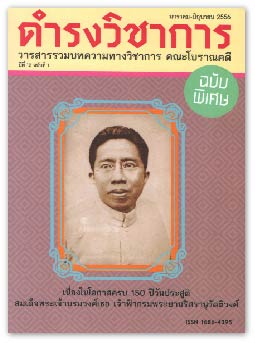TOURISTS' OPINIONS AND BEHAVIOUR TOWARD AUTHENTICITY IN NOSTALGIA TOURISM: A CASE STUDY OF 100-YEARS-OLD SAMCHU
Keywords:
ความจริงแท้, การท่องเที่ยวเชิงโหยหาอดีต, การท่องเที่ยว, วัฒนธรรมการท่องเที่ยว, ตลาดสามชุกAbstract
Authenticity has been one of the most debated issues in tourism studies for more than a decade. It is assumed that tourists search for authenticity and places which differ from those found in their daily lives. Nostalgia, which can be a form of cultural tourism, can fulfill these needs. However, in reality, tourists will always encounter the staged authenticity of tourism (MacCannell, 1973). This research aims at evaluating the authenticity of this tourist attraction based upon the criteria proposed by the Hoi An Protocols (2009). It surveys tourists’ opinions and behaviour towards authenticity under the management of nostalgic tourism and proposes suggestions for the sustainable management of nostalgic tourism. The study was conducted in the 100-Year-Old Samchuk Market Community, using data collected through in-depth interviews with outside scholars and market community members who also are tourism managers, through participant observation, and through questionnaires given to 100 tourists.
The results of this study show that nostalgia is the most important motivation for tourists to visit the 100-Year-Old Samchuk Market Community. This is because the community still seems to have authenticity in terms of location and setting as well as form and design. However, the authenticity in terms of the use and function of this place has already changed in response to the changing direction of nostalgia. That is, old markets now have new uses and functions as tourist attractions. The study further reveals that most tourists recognize and evaluate the authenticity of this place very well, however the originality/authenticity is not the main concern. According to the results of this study, the authenticity of tourist attractions will be the major challenge for the sustainable management of nostalgic tourism.
References
เกียรติ จิวะกลุและคณะ. ตลาดในกรุงเทพฯ: การขยายตัวและพัฒนาการ. กรุงเทพฯ: โรงพิมพ์จุฬาลงกรณ์มหาวิทยาลัย, 2525.
ดํารงราชานุภาพ, สมเด็จฯ กรมพระยา. ชีวิตและผลงานของสุนทรภู่. พระนคร: สํานักพิมพ์คลังวิทยา, 2513.
Baker, S. M. and Kennedy, P. F. “Death by Nostalgia: A Diagnosis of Context-Specific Case.” Advances in Consumer Research Vol 21, 169-174. In Allen C. T. and John D. R., eds. Provo UT: Association for Consumer Research, 1994.
Bower, M. “Marketing Nostalgia: An Exploration of Heritage Managementand Its Relation to the Human Consciousness.” Managing Archaeology, 33-39. In. M. A. Cooper, A. Firth, J. Carman, and D. Wheatley, eds. London: Routledge, 1995.
Scanlon, L. W. and Eheret, C. F. The Cure for Jet Lac. New York: Back2Press Books, 2008.
Chase, M. and Shaw, C. “The Dimensions of Nostalgia.” In The Imagined Past: History and Nostalgia, 1-17. In M. Chase and C. Shaw, eds. Manchester: Manchester University Press, 1989.
Cohen, E. “Rethinking the Sociology of Tourism.” Annals of TourismResearch6, (1979): 18-35.
David, F. Yearning for Yesterday : A Sociology of Nostalgia. New York: The Free Press, 1979.
Du Cross, H. “A New Model to Assist in Planning for Sustainable Cultural Heritage Tourism.” International Journal of Tourism Research, 3(2), 165-170. 2001.
Fridgen, J. D. Dimensions of Tourism. Michigan: Educational Instituteof American Hotel and Motel Association, 1996.
Golomb, J. In Search of Authenticity. London: Routledge, 1995.
Goulding, C. “Romancing the Past: Heritage Visiting and the NostalgicConsumer.” Psychology and Marketing 18,6( 2001): 565-592.
Hirsch, A. “Nostalgia : A Neuro-psychiatric Understanding.” Advances in Consumer Affairs Vol.19, 390-395. In Sherry, J. and Stemthal, B., eds. Provo UT: Association for Consumer Research, 1992.
Holak, S. L. and Havlena, W. J. “Nostalgia: An Exploratory Study of Themes and Emotions in the Nostalgic Experience.” Advances in Consumer Research, Vol. 19, 380-387. Provo UT: Association for Consumer Research, 1992.
Lowental, D. The Past is a Foreign Country. Cambridge: CambridgeUniversity Press, 1985.
MacCannell, D. “Staged Authenticity: Arrangements of Social Spacein Tourist Settings.” The American Journal of Sociology,79,3 (1973): 589-603.
McKercher, B. and Hilary du Cros. Cultural Tourism: The Partnership between Tourism and Cultural Heritage Management. New York: The Haworth Hospitality Press, 2002.
Timothy, D. J. and Boyd, S. W. Heritage Tourism. Harlow: PrenticeHall, 2003.
Trilling, L. Sincerity and Authenticity. London: Oxford University Press, 1972.
Wang, N. “Rethinking Authenticity in Tourism Experience.” Annuals of Tourism Research 26,2 (1999): 349-370.
UNESC0. Cultural Tourism. Accessed February 14, 2012. Available from http://portal.unesco.org/en/ev.php-URL_ID=13981&URL_DO=DO_TOPIC&URL_SECTION=201.html.
UNESCO. Hoi An Protocols: For the Best Practice in Asia. Bangkok: UNESCO Bangkok, 2005.
Downloads
Issue
Section
License
บทความนี้เป็นผลงานของข้าพเจ้าแต่เพียงผู้เดียว และ/หรือเป็นผลงานของข้าพเจ้าและผู้ร่วมงาน ตามชื่อที่ระบุในบทความจริง และเป็นผลงานที่มิได้ถูกนำเสนอหรือตีพิมพ์ที่ใดมาก่อน





